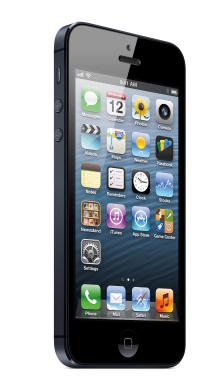The “iFixIt” gang has torn down the iPhone 5. You can find the complete teardown at http://www.ifixit.com/Teardown/iPhone-5-Teardown/10525/1 .
“Once we got the iPhone 5 on the operating table, the iPhone practically flew apart under our nimble spudgers,” says “iFixIt.” “Good news for all the phone droppers out there: the front glass/display is the first thing that comes off the iPhone 5! Replacing a cracked front panel is significantly easier than the iPhone 4/4S.
“And the further we delved, the more excited we got — even though we had to remove two pentalobe screws to get inside. The oft-broken and hard to repair home button now sports an integrated metal support bracket that should reduce the chance of failure, and the battery comes out just as easily as in last year’s model. Overall, the iPhone 5 received a very solid 7/10 repairability score!”
Here are some highlights of the teardown:
° “Because the iPhone 5 is opened front-to-back, replacing a cracked screen is going to be easier than ever. Thank you, Apple! Compare this to the iPhone 4S, where it took 38 [repair guide] steps to isolate the display assembly, and this iPhone may be the most repairable iPhone we’ve seen in a while.”
° “For the iPhone 5, Apple has switched to a different battery chemistry, with a higher voltage and slightly larger capacity than the iPhone 4S.”
° “On the back of the battery we notice “MFR Sony,” and ‘Cell made in Singapore.’ We think that it is very likely that Sony is manufacturing this battery.”
° “According to Chipworks, the B8164B3PM silkscreen label denotes 1GB Elpida LP DDR2 SDRAM. Yet the infographic presented during Apple’s Keynote clearly showed Samsung RAM (K3PE7E700F) in the A6. Not too long ago, Apple reduced their RAM orders with Samsung to diversify their supply chain. Time to invest in Elpida, or is Samsung lurking in the next phone on the shelf?”
° “Using an advanced precision scale (http://bit.ly/Pu9Wwd), we conclude that the entire rear case of the iPhone 5 weighs only slightly more than just the glass rear panel of the 4S.”
° “Unlike the iPhone 4S, which used a linear-oscillating vibrator, Apple has gone back to a rotational motor with a counterweight. We praised Apple in the past for going with the quieter and less annoying linear oscillating vibrator, but now we’re scratching our heads as to why they went back.”
° “Apple’s newest iteration of its classic home button sports an integrated metal support bracket, which we hope will greatly strengthen the oft-used switch. Many iPhone 4 and 4S users have experienced the woes of worn out home buttons, which are somewhat involved to repair. This new design should not only increase longevity, but also make replacing the home button a lot less of a hassle.”
° “Based on a reader request, we looked into the concerns about “Scuff Gate,” the fear that the black coating scuffs off too easily. We found that the side is pretty tough, but the chamfered edge can be susceptible to scuffing — making for a shiny streak on the side. Moral of this story: be careful, or get a case. Or be free like the wind and just don’t care.”
° “Apple is very proud of their decision to use a sapphire crystal in their new-and-improved camera. Sapphire would be a sensible choice to use as the outermost camera element because it is remarkably hard — a 9/10 on the Mohs hardness scale. We tried scratching the clear cover with a pair of steel tweezers and the lens remained scratch-free. While this doesn’t confirm that the protective cover is made from sapphire crystal, it does mean that it is quite hard and scratch resistant.



